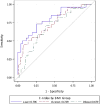Obesity's effect on asthma extends to diagnostic criteria
- PMID: 28624608
- PMCID: PMC6076889
- DOI: 10.1016/j.jaci.2017.04.047
Obesity's effect on asthma extends to diagnostic criteria
Abstract
Background: The use of inflammatory biomarkers to delineate the type of lung inflammation present in asthmatic subjects is increasingly common. However, the effect of obesity on these markers is unknown.
Objectives: We aimed to determine the effect of obesity on conventional markers of inflammation in asthmatic subjects.
Methods: We performed secondary analysis of data from 652 subjects previously enrolled in 2 Asthma Clinical Research Network trials. We performed linear correlations between biomarkers and logistic regression analysis to determine the predictive value of IgE levels, blood eosinophil counts, and fraction of exhaled nitric oxide values in relationship to sputum eosinophil counts (>2%), as well as to determine whether cut points existed that would maximize the sensitivity and specificity for predicting sputum eosinophilia in the 3 weight groups.
Results: Overall, statistically significant but relatively weak correlations were observed among all 4 markers of inflammation. Within obese subjects, the only significant correlation found was between IgE levels and blood eosinophil counts (r = 0.33, P < .001); furthermore, all other correlations between inflammatory markers were approximately 0, including correlations with sputum eosinophil counts. In addition, the predictive value of each biomarker alone or in combination was poor in obese subjects. In fact, in obese subjects none of the biomarkers of inflammation significantly predicted the presence of high sputum eosinophil counts. Obese asthmatic subjects have lower cut points for IgE levels (268 IU), fraction of exhaled nitric oxide values (14.5 ppb), and blood eosinophil counts (96 cells/μL) than all other groups.
Conclusions: In obese asthmatic subjects conventional biomarkers of inflammation are poorly predictive of eosinophilic airway inflammation. As such, biomarkers currently used to delineate eosinophilic inflammation in asthmatic subjects should be approached with caution in these subjects.
Trial registration: ClinicalTrials.gov NCT00495157 NCT00565266.
Keywords: Asthma; eosinophils; fraction of exhaled nitric oxide; inflammatory markers; obesity.
Copyright © 2017 American Academy of Allergy, Asthma & Immunology. Published by Elsevier Inc. All rights reserved.
Figures
Comment in
-
Biomarkers in obese asthma: Age of asthma onset matters!J Allergy Clin Immunol. 2018 Apr;141(4):1541. doi: 10.1016/j.jaci.2017.12.989. Epub 2018 Feb 2. J Allergy Clin Immunol. 2018. PMID: 29410044 No abstract available.
-
Reply.J Allergy Clin Immunol. 2018 Aug;142(2):713-714. doi: 10.1016/j.jaci.2018.02.030. Epub 2018 Apr 11. J Allergy Clin Immunol. 2018. PMID: 29655585 No abstract available.
References
-
- Boulet LP. Influence of obesity on the prevalence and clinical features of asthma. Clinical and investigative medicine Medecine clinique et experimentale. 2008;31(6):E386–90. - PubMed
-
- Peters-Golden M, Swern A, Bird SS, Hustad CM, Grant E, Edelman JM. Influence of body mass index on the response to asthma controller agents. Eur Respir J. 2006;27(3):495–503. - PubMed
Publication types
MeSH terms
Substances
Associated data
Grants and funding
- U10 HL074227/HL/NHLBI NIH HHS/United States
- U10 HL098107/HL/NHLBI NIH HHS/United States
- T32 AI007062/AI/NIAID NIH HHS/United States
- P30 ES006694/ES/NIEHS NIH HHS/United States
- U10 HL074208/HL/NHLBI NIH HHS/United States
- U10 HL074218/HL/NHLBI NIH HHS/United States
- U10 HL074204/HL/NHLBI NIH HHS/United States
- U10 HL074231/HL/NHLBI NIH HHS/United States
- U10 HL074225/HL/NHLBI NIH HHS/United States
- U10 HL074073/HL/NHLBI NIH HHS/United States
- U10 HL074212/HL/NHLBI NIH HHS/United States
- U10 HL074206/HL/NHLBI NIH HHS/United States
LinkOut - more resources
Full Text Sources
Other Literature Sources
Medical
Research Materials


